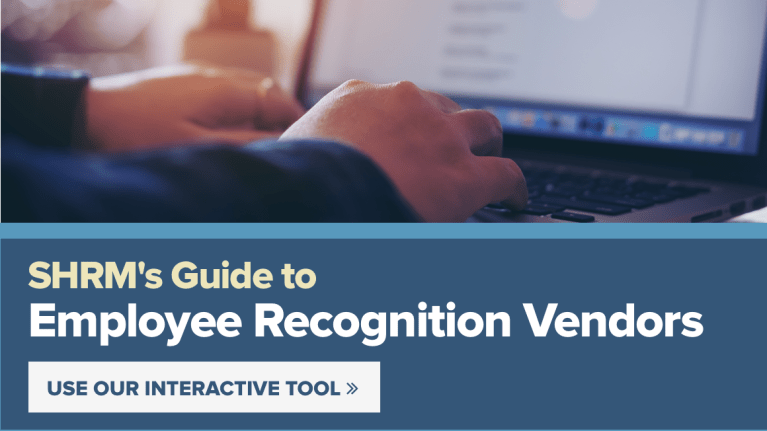Put Recognition in Your Employees' Hands
Peer-to-peer recognition is most effective—especially when it's easy to do

The importance of recognizing employees for their good acts has never been lost on HR leaders, but new research shows that meaningful recognition may be more important than ever in retaining top employees and keeping pace with competitors.
Such recognition isn't possible for large employers without modern technology. Today's employee-recognition vendor platforms can, at a minimum:
- Facilitate rapid peer-to-peer feedback.
- Create social media "walls"—like oversize Facebook pages—that amplify recognition by allowing more workers to celebrate their colleagues' accomplishments publicly.
- Provide analytics that help leaders better understand the impact of recognition on employee engagement and business results.
Yet, as with any technology, some key factors separate the best from the rest. Leading platforms:
- Allow employees to recognize peers quickly and easily within the flow of daily work.
- Offer a variety of custom rewards.
- Help organizations model good behavior for the entire workforce with social recognition features.
[SHRM members-only online discussion platform: SHRM Connect]
Recognition Key to Retention and Results
Employee retention is HR's top challenge, according to a 2018 report on employee recognition, conducted jointly by the Society for Human Resource Management (SHRM) and leading employee-recognition software company Globoforce. About half (47 percent) of HR professionals cited employee retention/turnover as their top workforce management challenge this year. Many companies are struggling to retain employees in an economy characterized by low unemployment and a growing number of job hoppers and gig workers.
Recognition is one way to ensure employees feel valued and become less likely to look for greener pastures. It's also an integral component of successful companies. A 2018 study by HR research and consulting firm Bersin, Deloitte found that high-performing companies were 1.7 times more likely than low-performing companies to have a rewards philosophy that included frequent recognition as a key part of their business strategies.
"High-performing companies in the study also were 10 times more likely than their low-performing counterparts to use their employee recognition programs as a competitive differentiator," said Pete DeBellis, total rewards research leader at Bersin, Deloitte. The Bersin study surveyed HR and other functional leaders in 1,200 organizations globally.
Evaluating Platform Vendors
Three factors differentiate top recognition vendors from others, said Brian Kropp, group vice president of the HR practice at research and advisory firm Gartner.
The first is that the best providers understand that peer-to-peer recognition matters more to employees than manager recognition, a consistent finding in Gartner's research on recognition practices. "Platforms should have a simple way to enable peer-to-peer recognition," Kropp said.
The second differentiating factor is speed. "Every day that passes between when a positive employee behavior happens and when the recognition is given, the value of that recognition declines," Kropp said.
"It is no longer about nominating someone and requiring that one or two managers sign off on the nomination, but [instead] giving employees the kind of decision support or training where they can initiate and complete the whole recognition process themselves," DeBellis said.
Autumn Manning, co-founder and CEO of reward and recognition platform provider YouEarnedIt, said timeliness is crucial.
"If you are trying to help employees and managers create a habit of saying thank you and sending meaningful feedback, it needs to be in real time," Manning said. "Giving feedback should be easy and simple, without [manager approval]. You see an increase in engagement over time when that happens."
The third differentiating factor is social recognition, or the ability for the wider workforce to see who is being recognized for what specific actions. Kropp said the best programs model the recognized behavior for the rest of the company.
"Our research has found [that] the biggest value recognition can have is the standard that organizations set for what great work looks like that the whole company can see," he said.
Top platforms also give employees options for recognizing their peers. Globoforce, for example, says its clients are using video-based recognition, where workers record and send videos to peers to celebrate their accomplishments.
"Video helps animate recognition," said Derek Irvine, executive vice president of strategy and consulting services at Globoforce. "When employees create a video on their smartphone and send it to teammates, it adds a compelling personal touch to the recognition."
Importance of Modern Technology
Intuitive interfaces and ease-of-use are necessary attributes.
"Top providers have technologies that make it easy for peers to quickly recognize others and also integrate with other communication platforms to make the recognition process seamless and to broaden its impact," said Gary Beckstrand, vice president of the O.C Tanner Institute, an arm of recognition vendor O.C. Tanner. Buyers of recognition platforms have expectations for similarly modern, consumer-grade systems.
Automated tools also can help busy managers remember to recognize people amid the rush of daily tasks. Some platforms have features like automated e-mail with report cards showing how many times a manager has recognized others in certain periods.
Kropp said recognition platforms should mirror the consumer apps that employees use. "Employees can do their banking on their phone, they can buy a car on their phone, they can get directions on their phone," he said. "But when they come to work they often have to step back in time in terms of the dated technologies they're asked to use. You don't want your technology getting in the way of people's ability to recognize one another."
Experts say recognition systems should allow employees to choose from a wide variety of rewards.
"I still see a lot of cookie-cutter, out-of-the-box rewards fulfillment on platforms," DeBellis said. "But we are starting to see more unique recognition options around choice of experiences, learning opportunities, making charitable donations on employees' behalf and organization-specific rewards that tap into people's emotions."
Platform Analytics Evolve
More platforms now feature analytics tools that can help HR leaders identify the impact of recognition activities. They can track the cost of recognition, distribution of awards—whether one person or group is being recognized disproportionately over others—and correlate recognition data with other business metrics.
"For example, does the data show if recognition is a proxy for engagement, or might it be a leading or lagging indicator for engagement?" DeBellis asked.
Analytics should help leaders understand who is being recognized from which parts of the company for what specific actions, as well as how recognition investments impact key performance indicators, Beckstrand said. "That allows you to measure the impact of recognition programs over time with an ability to correlate recognition data with things like employee retention or customer satisfaction."
Dave Zielinski is a freelance business writer and editor in Minneapolis.
An organization run by AI is not a futuristic concept. Such technology is already a part of many workplaces and will continue to shape the labor market and HR. Here's how employers and employees can successfully manage generative AI and other AI-powered systems.




